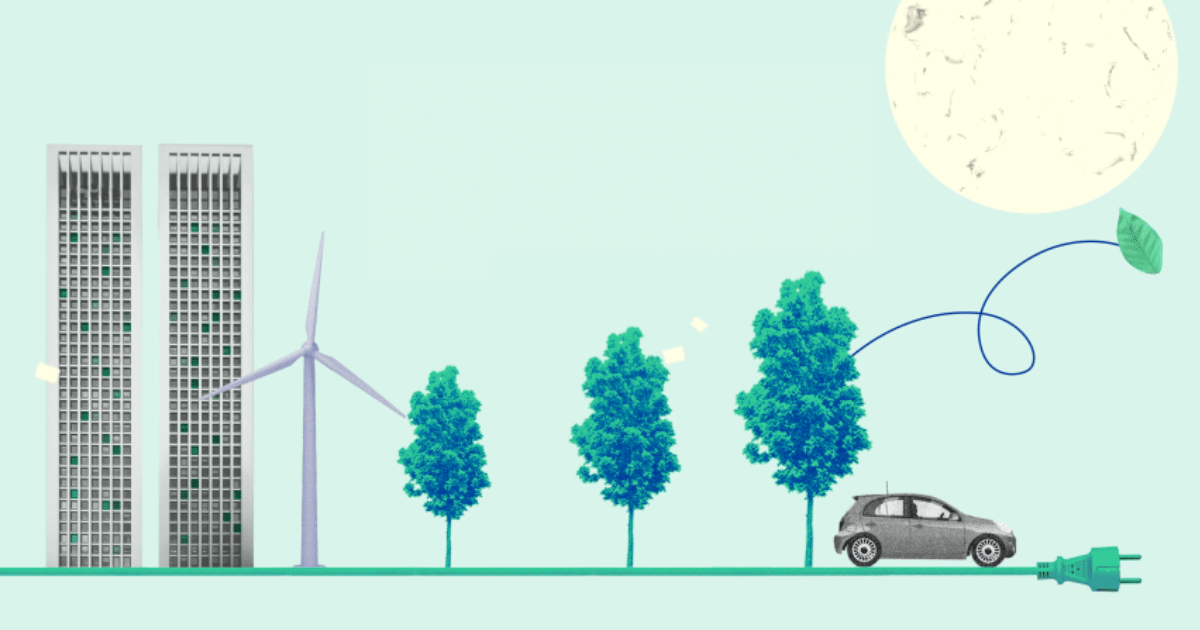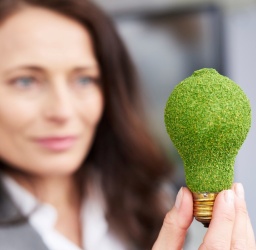8 ways life in the EU is becoming greener

Shifting to a greener way of life is crucial to address the climate emergency and reduce our dependency on fossil fuels, especially those from Russia.
The EU and its 27 countries are working on new common rules within the so-called ‘Fit for 55 package’ to reduce the EU’s carbon footprint. The objective is to cut net greenhouse gas emissions by at least 55% by 2030.
How will these new rules shape the way we live, work and travel? Read on for some examples of what life in the EU will look like in 2030.
EXPLORE ALL TRAINING OPPORTUNITIES FOR ENERGY, ENVIRONMENT & SUSTAINABILITY
#1 Homes are powered with cleaner energy
Any plan to cut emissions in the EU has to start with reducing the carbon impact of the energy sector, which powers buildings, industries and transport. Today this sector accounts for 75% of all EU emissions.
Under the new rules, by 2030, Europeans will get 42.5% of all their energy from renewable sources, from solar and wind power to hydroelectric and geothermal energy. Renewable energy is cheap to generate, can be produced in the EU and benefits from free and infinite natural resources.
As the use of renewable energy has so far been uneven across different economic sectors, the new rules aim to set specific objectives for each sector: for example, defining the share of renewable energy to be used in buildings, or of renewable hydrogen to be used by industry.
Shifting to renewables reduces greenhouse gas emissions from the energy sector, and also improves air quality and human health.
New legislation is also expected to address, for the first time, methane emissions generated in the energy sector, enforcing stricter limits and making monitoring and reporting compulsory.
#2 Cars pollute less than before
Road vehicles are currently the biggest source of transport emissions in the EU, accounting for 71% of the total.
While vehicles powered by fossil fuels – petrol, diesel and gas – will continue to be on our streets for years to come, new EU rules will pave the way for cleaner cars and vans.
By 2030, emissions from new cars and vans will on average have to drop by half compared to 2021 emissions. Five years later, new cars and vans placed on the EU market will have to be zero-emission.
The new rules to green the sector are due to come into effect in stages, giving manufacturers an opportunity to adapt to them. New vehicles – either electric or powered by alternative fuels, such as hydrogen – will need sites and infrastructure to refuel and recharge. That is why there are plans to build many more recharging and refuelling points across the EU by 2030.
#3 Buildings emit no CO2
Buildings are today responsible for over one third of the greenhouse gas emissions in the EU.
Reducing emissions from buildings – through either reduced energy consumption or increased use of renewable energy – is crucial. The new proposed rules would set more ambitious energy efficiency standards for both residential and non-residential buildings.
Under those rules, all new buildings would be zero-emission by 2030 and energy performance certificates for such buildings would be obligatory. New residential buildings would need to have solar energy installations. There would also be a greater number of recharging points and parking spaces for e-bikes and electric cars. The legislation also aims to encourage property owners across the EU to renovate their buildings, with the ultimate goal of ensuring that all buildings in the EU are zero-emission by 2050.
08/11/2023 Σεμινάριο Ζωτικής Σημασίας: Εφαρμογές Κυκλικής Οικονομίας για Εταιρείες Διαχείρισης Αποβλήτων (100% Επιχορηγημένο)
#4 Construction materials are greener
Producing cement, steel and glass requires large amounts of energy and has a high environmental cost. EU legislation provides financial incentives for those industries to reduce their emissions.
The EU emissions trading scheme (EU ETS) puts a price on CO2 emissions through a trading system for ‘carbon permits’. The number of permits made available each year will gradually be reduced, with the aim of reducing emissions.
The current EU ETS covers approximately 10 000 large plants in the following sectors:
electricity and heat generation
energy-intensive industry sectors (such as oil refineries, steel and cement)
commercial aviation in the European Economic Area
The new rules include a more ambitious emissions reduction goal for those sectors by 2030. The maritime sector will also be covered by emissions trading. A separate carbon market will be created to cover companies selling fossil fuels for use in buildings, road transport and small-scale industry.
Because of high carbon pricing, there is a risk that certain energy-intensive industries will increase their production outside the EU, in countries with less strict climate policies.
To address this risk, known as ‘carbon leakage’, importers of certain products subject to the carbon border adjustment mechanism (CBAM) will have to compensate for the difference in carbon price as of 2026.
Products covered by the mechanism include:
iron and steel
cement
fertilisers
aluminium
hydrogen and electricity
#5 Home appliances use less power
Producing energy cleanly is only half the battle – not wasting it is just as important. In fact, saving energy is the most cost-effective solution for a climate-friendly energy sector.
Home appliances are just one of the areas targeted by the EU energy efficiency legislation. Other ways to save energy include bespoke renovations in buildings for better insulation, rolling out smart meters for utilities, improving the monitoring and certification of energy systems, and technological advancements to reduce energy use in transport.
The new rules will make it compulsory for EU countries to reduce energy consumption by 38% by 2030 (for final energy consumption, that is the amount of energy consumed by end users). This is 5.5% more than what EU member states committed to in 2018.
Each member state will have to take measures to cut energy use. The sectors most concerned are:
buildings
industry
transport
EXPLORE ALL TRAINING OPPORTUNITIES FOR ENERGY, ENVIRONMENT & SUSTAINABILITY
#6 Flying has a lower carbon footprint
Aviation currently relies almost exclusively on fossil fuels. Travelling by air has a high impact on the EU’s overall emissions record. For example, a return flight from Lisbon to New York generates roughly the same level of emissions as an average person in the EU does by heating their home for a whole year.
Under the new rules, the aviation sector will see an increase in the use of sustainable fuels. Suppliers of aircraft fuel will be required to gradually increase the share of sustainable fuels (such as synthetic fuels or advanced biofuels) that they distribute.
Flights within the EU will continue to be included in the EU emissions trading system, which provides incentives for airlines to reduce their emissions. A progressive reduction of free allowances (to emit carbon) will push airlines to take further measures to cut their emissions.
For flights from the EU to the rest of the world, another measure is in place: airlines are required to offset emissions in accordance with the rules defined by the International Civil Aviation Organization.
#7 Transport by sea is more climate-friendly
On top of putting a carbon price on maritime transport, the new rules will require ships calling at European ports and weighing more than 5 000 gross tonnes – whether cargo or cruise ships – to gradually cut their emissions by 2030 and beyond. Just like aviation, the maritime sector predominantly uses fossil fuels. The new legislation will encourage the use of more sustainable fuels, in particular for the largest ships, which generate 90% of all emissions from the maritime sector. Some exceptions will apply, for instance for fishing vessels.
In addition, access to shore-side recharging facilities will need to be available for moored ships as of 2030 in order to mitigate air pollution in ports, which are often close to densely populated areas.
08/11/2023 Σεμινάριο Ζωτικής Σημασίας: Εφαρμογές Κυκλικής Οικονομίας για Εταιρείες Διαχείρισης Αποβλήτων (100% Επιχορηγημένο)
#8 Nature is an ally against climate change
While the top priority is to rapidly cut emissions, removing CO2 from the atmosphere will also help to reduce our carbon footprint and help the EU achieve its aim of becoming climate-neutral.
Enhancing CO2 removal by carbon ‘sinks’ will become increasingly important in order to compensate for the emissions that are hardest to eliminate. Sinks include natural and technological solutions.
Trees and other plants act as natural sinks that absorb CO2 from the atmosphere and capture it as part of their natural photosynthesis. The EU is aiming to progressively increase its natural sinks, and has set itself a new ambitious target of increasing net removal by 25% compared to the level of removals achieved in the EU as a whole in 2019.
Making the green transition happen will require major transformation and investment. For the current long-term budget, running until 2027, EU countries have decided to devote up to 30% of all EU funding to climate-related action – this amounts to almost €550 billion. Additional funds, such as the Innovation Fund and the Modernisation Fund under the EU ETS, as well as the Social Climate Fund, will also contribute to the shift to greener policies.
This funding not only supports new and innovative projects but also provides financial support to citizens and companies bearing the cost of the transition. For instance, vulnerable citizens who struggle with their energy bills may be eligible for financial assistance from the future Social Climate Fund.
According to the World Meteorological Organization, the past few years have been among the warmest on record. Heatwaves, drought and devastating flooding have impacted the lives of millions of people.
Humanity stands at a turning point: will we do what is necessary to avoid the worst effects of climate change?
Europe is ready to do its bit.
Share:
Διαβάστε Επίσης
Συμβάλλοντας στην επίτευξη των εθνικών και ευρωπαϊκών στόχων για βιώσιμη ανάπτυξη.
Και η απάντηση ίσως ξεκινά από το πιο προσωπικό επίπεδο....
 Ελληνικά
Ελληνικά  English
English


